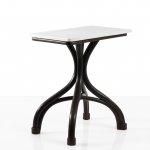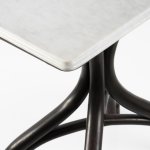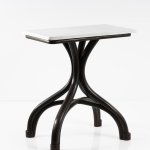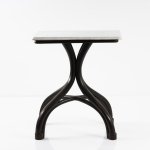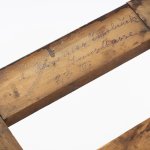Lot: 60
Caféhaus table 'Nr. 8', c. 1866
H. 76 cm, 67.5 x 46.5 cm. Made by Thonet, Vienna, c. 1900. Beech bentwood, beech, stained in mahogany, white marble.
Adolf Loos used this table model to furnish the famous Café Museum in Vienna, which opened in 1899. The original equipment was used until 1931. Subsequently, the café was refurbished by the architect Zotti.
Hammer Price: 3,600 €
03. December 2019 at 4:00 PM CET
Literature:
Ostergard, Bent Wood and Metal Furniture, New York 1987, p. 100, p. 224; cf. Bangert/Ellenberg, Thonet Mobel, Munich 1997, p. 96. www.cafemuseum.at
200 Years of Thonet (1819-2019) Thonet, founded by Michael Thonet in Vienna in 1853, is one of the leading brands in bentwood design. Many of the Thonet brothers' products are considered icons and have shaped the history of furniture design. The brand's success was primarily due to its exceptional production technology. By soaking the wood during the production process, Michael Thonet succeeded in obtaining new shapes through bending. Thus the bentwood furniture was born. In addition, the furniture parts were sold in individual parts and assembled by the customer himself with the help of screws. This enabled the company not only to introduce new models for the furniture industry, but also to ensure mass production that met the requirements of the modern, industrialised society. In the final phase of Thonet's development, the company, in collaboration with various artists, concentrated more and more on the respective designs in order to limit the number of articles produced.
The variety of Thonet pieces offered at the auction belongs to different production stages of the company. Starting with the famous 'No. 14' chair, to exceptional examples of bentwood design such as the 'A811' chair, to innovative and minimalist plywood furniture such as Gropius' and Thompson's 'W199a' armchair and Verner Panton's 'S-chair - 275'. This diversity of forms not only reflects the historical development of furniture production, but also shows that even the early Thonet pieces seem contemporary and unique. The development of the Thonet design is particularly evident in the catalogue numbers 89 to 115.
Read our Terms & Conditions.





